|
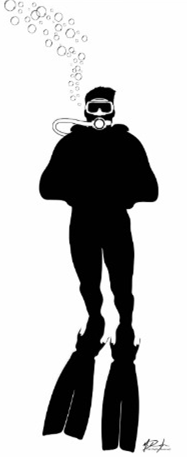

Dive Log
Back to

Back to

|
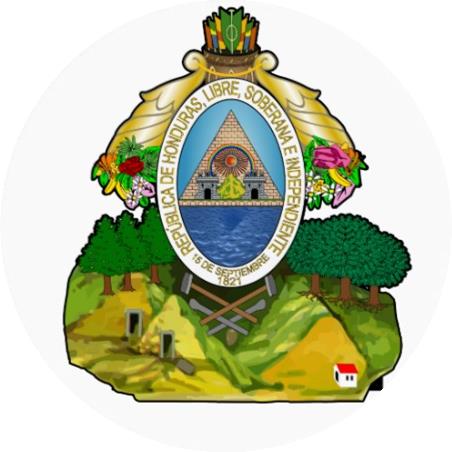
Guanaja, Honduras
June, 1987
I mentioned previously that we had, on
occasion, unintentionally selected island to dive that were in
war zones. This was true of our trip in 1987 to Guanaja
off the coast of Honduras.
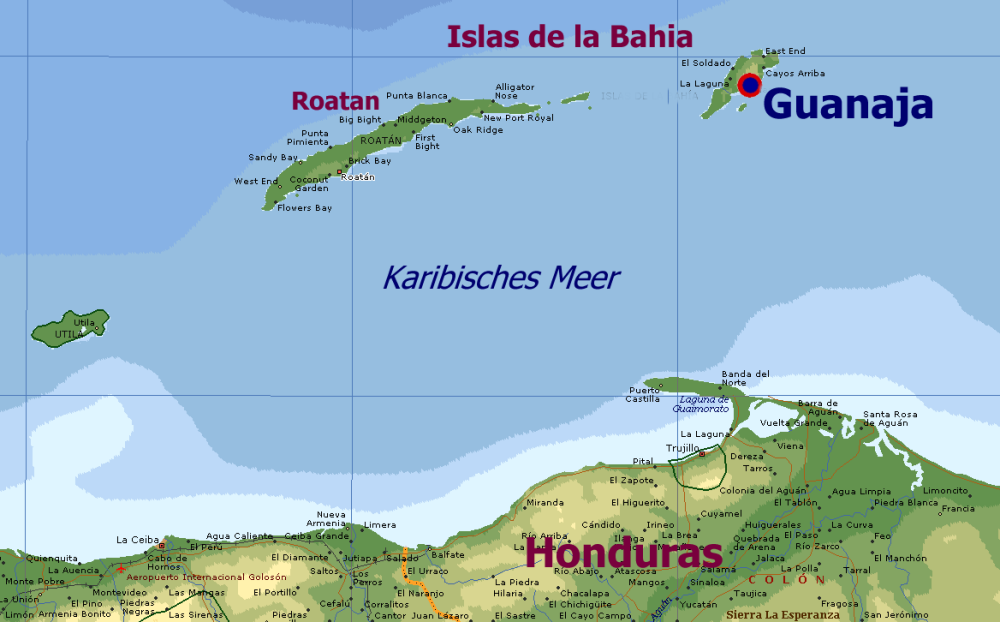
We had made our reservations several
months in advance to assure a slot. Between the time we
made our nonrefundable reservations to a few weeks before our
departure, the newspapers were full of articles of riots and
bombings in Honduras. We have been known to take chances,
but nothing so foolhardy as to enter a war zone. We called
the hotel with our concerns. They assured us that what we
had read was greatly exaggerated and in no way affected the
island or our trip. Since most of the trouble was south
and we wouldn't be landing in San Pedro, we would sit tight and
wait to see how things played out. Shortly after our call,
there was no mention in the papers of any further trouble.
|
A bit of history...
Guanaja was discovered by Christopher
Columbus on his fourth voyage in 1502. Notably, this was the
first time he came across cacao, which is the core of chocolate.
He landed on Soldado Beach on the north side of the island. In
later years Cayman Islanders settled in the Bay Islands, which
explains the diffusion of Spanish and English language.
Columbus called it Isla de Los Pinos
(Isle of Pines) although it already had a name, Guanaca,
used by the natives that inhabited it. This name appears as
early as 1511 on a map drawn by Peter Martyr but it later was
corrupted by English pirates, privateers and settlers and was
pronounced Bonacca. There has been other names for the island
over the years before the Bay Islands were turned over to
Honduras as the English, the Dutch and the Spaniards modified
the name to their liking.
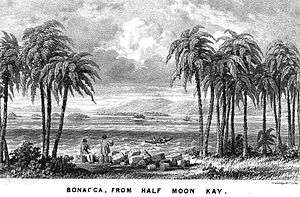 |
Upon
gaining possession of the Bay Islands the Honduran
government made Guanaja the official name of the
island but the residents kept the old name for as long
as they could and older inhabitants throughout the
islands still call it Bonacca. The main settlement is
called The Cay, an abbreviation of Lower Cays, the
original name. It was first settled by the Haylocks who
had moved to the two little cays that lay about a half
kilometer off the south shore of the main island to get
rid of the flies that plagued them during calm nights.
They eventually stayed and later sold the southernmost
cay (Hog Cay) to the Kirkconnells. Many other families,
among others the Bordens, the Phillips and the Woods,
came later and by the 1880s a thriving community had
developed. |
Homer Hickam, author of Rocket
Boys/October Sky, was one of the first scuba explorers of
Guanaja, first visiting in 1973. Along with a team of other
scuba explorers, he extensively mapped the reef system around
the island for sport divers. He still owns property on the
northeast end of the island.
The primary source of income for the
islanders is fishing and shrimping. Tourism is confined to a
handful of small resorts that cater to divers, snorkelers and
adventure travelers. The island's warm, clear waters support an
extensive coral reef that is part of the Mesoamerican Barrier
Reef and second only to the Great Barrier Reef off the coasts of
Australia. Currently, there is still access to fresh water on
Guanaja, and several waterfalls can be seen. |

Our flight was scheduled to leave Omaha on
June 4 in the early hours of the morning. Our flight was
then directed to Dallas and from there we would transfer to Tan
Shasha Airlines for the flight into Honduras and on to Guanaja.
Tan Shasha was the airline of the Central Americas at the time.
Their fleet of planes consisted of 707s and DC-3s. The
interiors were nothing to look at; seating was tight, and
smoking was permitted on all flights. There were no
seating reservations on the DC-3s so it was
first-come-first-seated.
After a three-hour layover, we boarded our
flight for La Ceibe Honduras. The airport in La Ceibe
hadn't changed since we were last there in '83. After
customs and a bag check, we waited in the air conditioned room
reserved for flight passengers. There were no roads or
telephones on the island, just sea and land and diving.
A dive boat transported us from the
Guanaja Airport in the twilight hours to Pasada Del Sol; our
home for the next eight days.
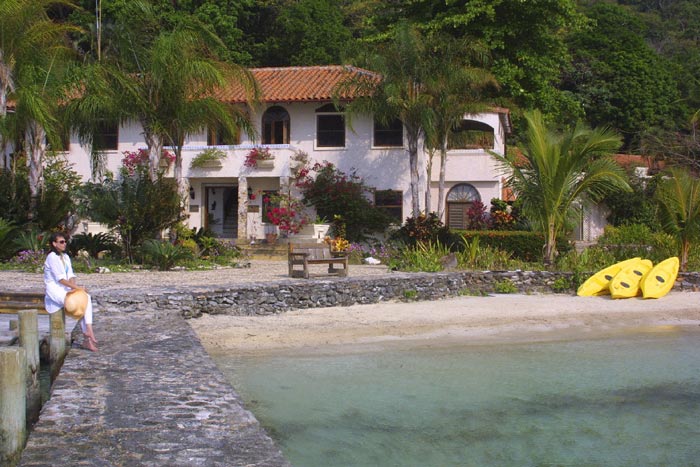 |
We were
greeted at the door by a pair of large dogs who became
everyone's companions for their stay. Also
greeting us with a rum-punch drink in hand was the
hotel's manager, Dave. When all of the guests had
arrived, we sat at poolside for our instructions.
Our room was #11 - Sagittarius - on the upper level
close to the pool and butted up against the wall of an
inactive volcano on which the hotel was built.
Originally, the inn was a private
residence. Having a dozen or so rooms, pool, bar,
and dining area, Posada Del Sol was a beautiful facility
with one exception - there was no breeze in the rooms
regardless of how windy it was outside. The only
relief came from the ceiling fan. We rearranged
the room so that our beds were directly under the fan
for sleeping. In the morning we were ready to go.
Another diving adventure awaited. |
Breakfast at the Inn was as much and as
formal as you wanted. Eggs, pancakes, waffles, omelets,
cereal, breads, coffee, juice, whatever your pleasure. The
dining area would accommodate the guests and a few more and
table were arranged to seat to to twenty. The napkins were
always folded in different figures for each meal. It was
an extra touch we always remembered.
After breakfast we went to the dive shop
for a short presentation on procedures and to check out our
weights. Our checkout dive was at "Lee's Pleasure."
Enter the water, each diver was asked to remove their mask,
replace and clear it. The remove their regulator, purge
and replace it. This being done, we were off. This
was the first dive with a new pair of fins that were purchased
to replace a bulkier pair. The fins worked like a charm
but the straps had to be modified to avoid chafing the heal.
Posada ran three dives a day; two morning
and one afternoon. We would often replace the afternoon
dive with some other scheduled trip such as a tour or hike.
But in the beginning, we made every dive. The first
day we dove "Hector's Run" and "George's Wreck." The elk
horn coral formations were spectacular and leaf coral varied in
colors of greens, yellows, rust, and reds. The reefs were
extremely clean and relatively free of urchins (urchins
literally devour a reef).
One serious problem we experienced was sea
sickness. We attributed this to sinus conditions and
rolling waves. It was serious enough that Dad had to vomit
while diving; a tricky feat through a regulator. We tried
various doses of Dramamine and Sudafed but nothing seemed to
work. That queasy feeling never left the entire week.
Dad also ran into a related problem of his ears not clearing.
Lunch was more food than anyone has the
right to eat but the menu was so tempting it was hard to resist.
From grilled fish to fajitas to hamburgers and quiche, each
lunch was a delight and topped off with desert. Joining us
for lunch were a pair of parrots that sat on their swinging
perches squawking, whistling, and repeating phrases in Spanish
and English taught them by the guests and employees.
There was a diverse group of divers there
that week. One couple, who had breakfasted with us each
morning, was the mayor of Deerfield, Illinois and his wife.
Becky and Herb were a charming couple with a rugged outdoor
appearance. They owned two jewelry stores as well as a
bakery. Their first shop was in an old bank that they had
modernized but yet retained the charm of its original structure.
They made and specialized in custom jewelry and wax castings.
I have no doubt about their success judging from the quality of
the work they were wearing. The name of their shop
reflected their lifestyle; Voyagers.
A fireman and his wife - Ron and Carol -
were another pair. Ron was boisterous. When we dove,
he was almost head-down vertical. How he managed to
maintain that position is beyond me. He looked like a file
fish. Carol was working on finishing her diving
certification which she did by the end of the week.
Then there was a group from Texas (sound
familiar?). A man (Don) and his wife and daughter.
Of the three, Don was the only diver. Frosty White
(yeah...that was her name) had a quick wit and charming
personality. She was the life of the party. Frosty
worked at a nuclear power plant.
The next day we dove "Silver Load",
Afternoon Delight", and "Windmill Reef". "Silver Load" we
would dive on more than one occasion. The group dove down
a permanent mooring line to the reef and then down an additional
70 feet to where a tunnel went through the reef into a bowl.
The bowl was a chumming area for large barracuda, eel, and
schools of grouper, lemon tails, and sea bass. We sat as
the Dive Master fed the fish.
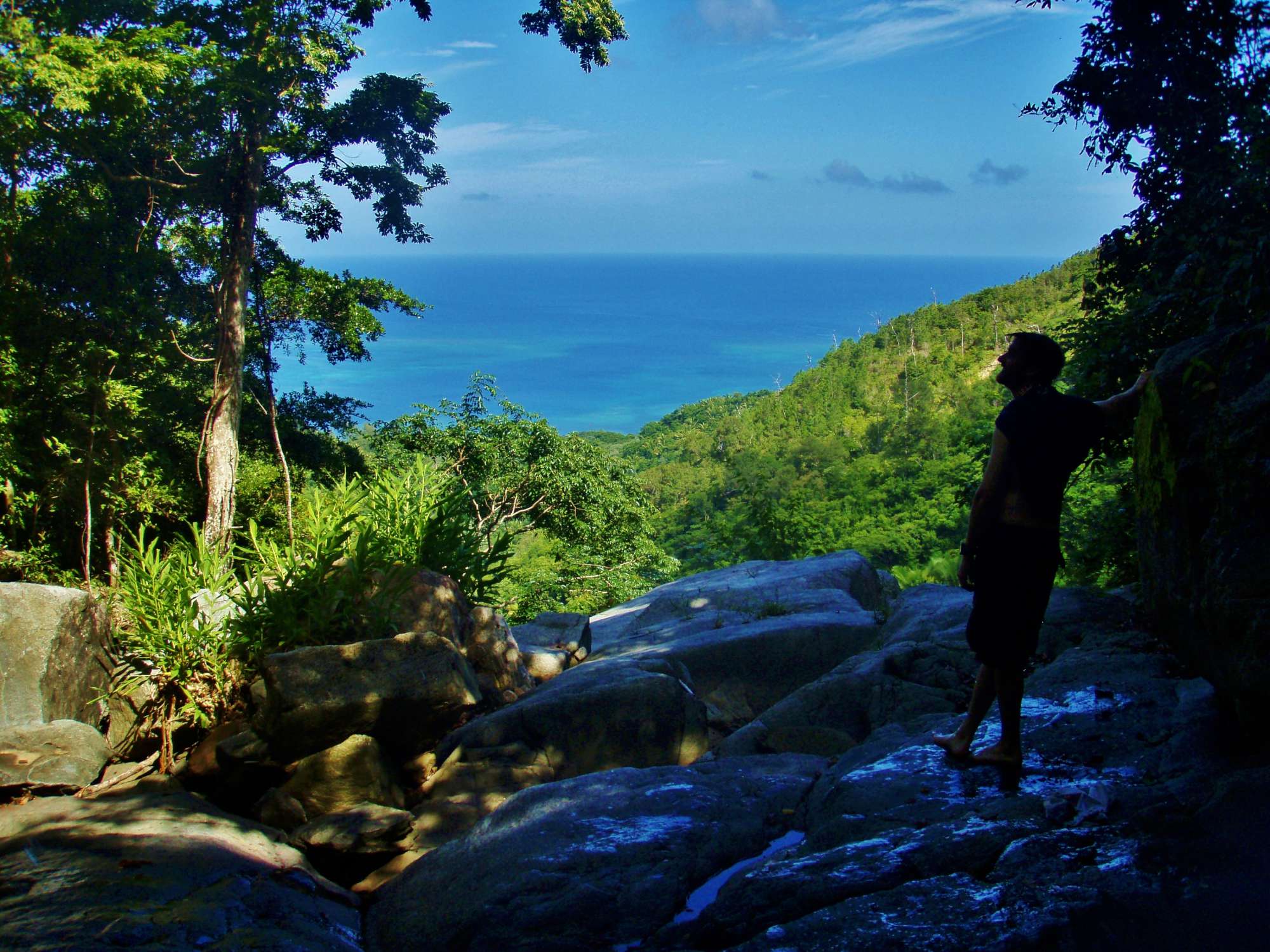 |
That
afternoon I made the mistake of taking what is
rightfully called the Death March. It was a trip
up the mountain behind the hotel. Granted, the
scenery was fabulous but one false step would have
spelled the end to diving for the week. Most of
the guests started the hike, a few made it to the first
stop. Dad and a few more went to the next stop.
Myself, Herb, Ron, Carol, and our spry tour guide went
to the top...and oh yes, the dogs were with us.
What surprised me was the mountain was covered with pine
trees - thus the original name of Island of the
Pines. The trek was exhausting and I returned
almost two hours later with not an ounce of energy or
dry clothing. |
Dinner was always an experience. We
never had the same meal twice. Soup or salad came first
along with fresh hot bread. The main course might have
been fish, chicken, kabobs, or lobster. The deserts
included key lime pie, coconut or banana cream pie, ice cream,
etc. We weren't big bar attendees but the local beer was a
refreshing Pilsner and the mixed drinks were smoooootttth.
"Vertigo" was our first float dive -
similar to a drift dive. The boat took us to what appeared
to be the middle of the ocean and, with difficulty, tied to an
anchoring. The seas were rough. Gearing up was
difficult and once in the water it was a workout to get to the
anchor line. While we waited for the rest of the divers to
arrive, our air supply continued to decrease. The Dive
Master ended up having to cut the anchor line loose. The
purpose of the dive was to see the rare cricoid (sp?) stars;
similar to a brittle star but much larger.
We spent our surface time on a nearby
island where the crew supplied us with fresh coconuts. The
bay was home to large schools of fish and with fish you get
pelicans. In the safety and shelter of the bay, large
numbers of brown pelicans could be seen folding their wings and
plummeting into the water for a meal. Not very graceful,
but very efficient.
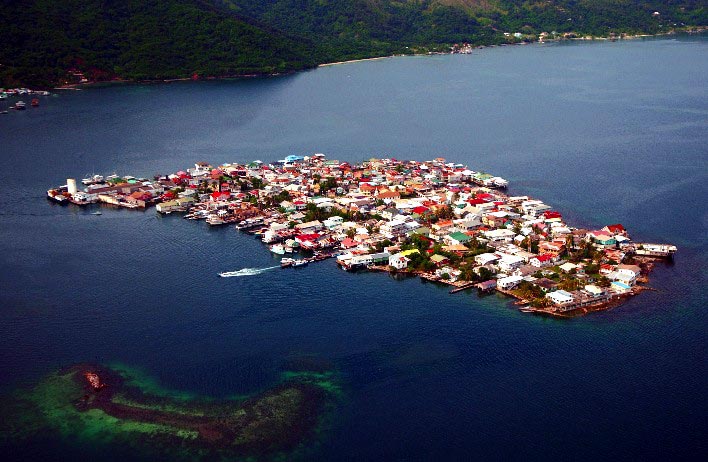 |
That
afternoon we opted to take a tour of Bonaca - Venice of
the Caribbean. We took one of the older dive boats
to the island with its houses built on stilts.
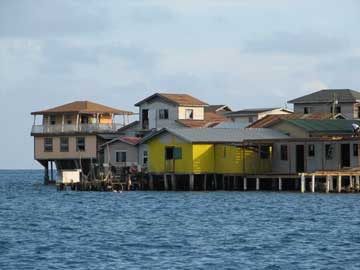 |
Originally just a small volcanic
outcropping, natives began to build on the island to avoid the
no-see-ums of the mainland. As the population grew,
residents were forced to build further towards the water's edge
and even over and in the water. Thus the appearance of
Venice. The boats used to navigate the limited waterways
are also narrow and are usually dugouts made of mahogany.
In earlier days when the island was really
two distinct haves, a pig farmer set up operation on one end of
the island. The smell got so bad that eventually the
farmer was evicted to a location downwind. That area of
the island is still known as Pig Key. The population at
the time was around 5,000 and the living conditions were
poverty. While they had no local pollution, the refuse of
other islands was left along the shoreline by the ocean current.
We toured the fish factory - which was the major source of
income for the island - and walked through the small town.
You don't appreciate what you have until you visit a place like
Bonaca.
| The
following day was the typical island mid-week picnic.
We were scheduled to spend the day on the opposite side
of the island, eat lunch, dive, and return for dinner.
The boat ride was extremely rough. At the tip of
the island is a lighthouse and around the opposite side,
diving was as different as night and day. We dove
"Volcano Caves" and "Paradise" which were volcanic
projections onto which little of anything grew.
There were not the coral reefs of the other side of the
island; just outcroppings of lava that had cooled when
it hit the water creating numerous passageways and
shallow caves. Dad had problems clearing his ears
and chose not to make the dives.
The picnic at Paradise came complete
with chicken, coleslaw, potato salad, and bugs. After
eating, everyone headed for the water for relief from
the sun and insects. Being the only person who
wanted to visit a nearby waterfall, I turned down the
trip so as not to delay the others. Judging by the
pictures...it would have been worth the trip.
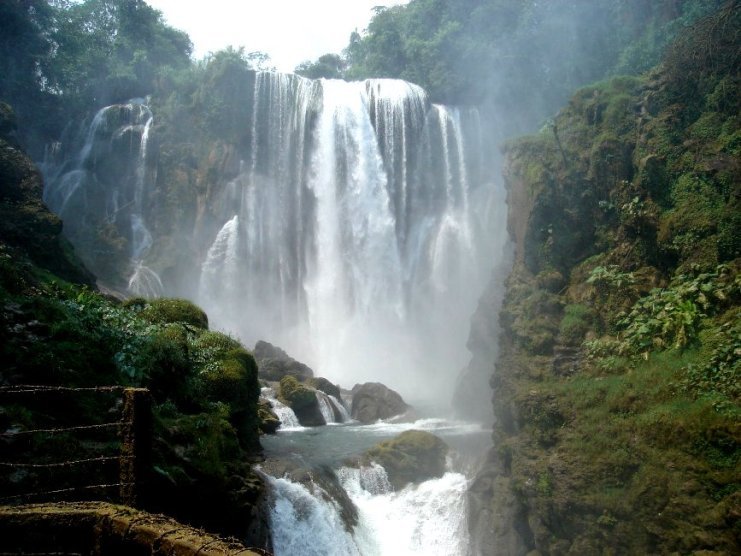 |
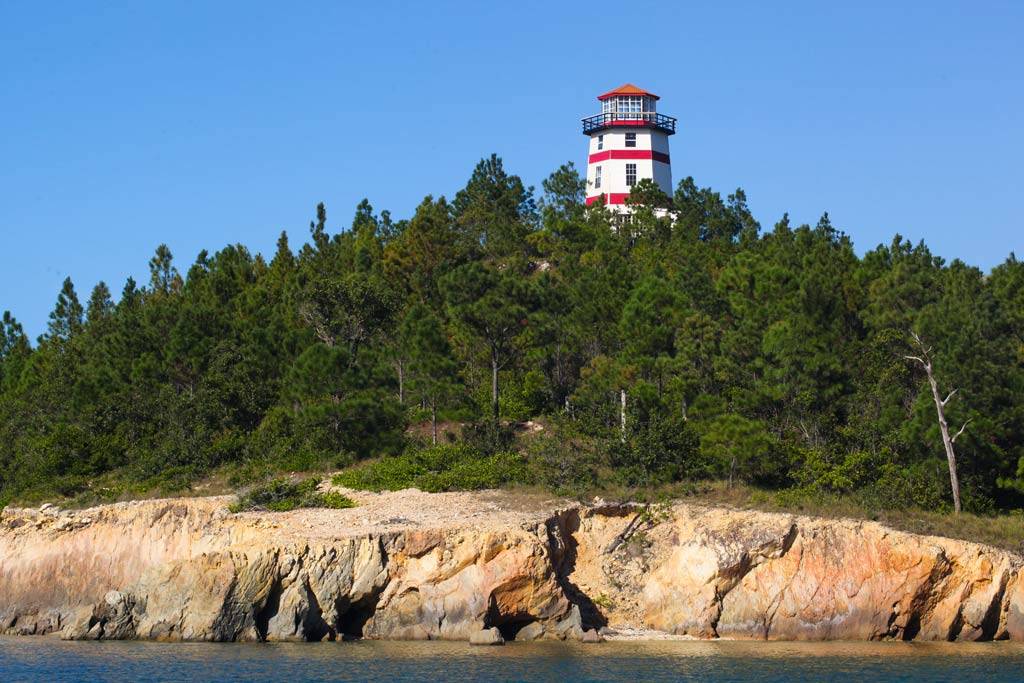
That afternoon we dove "Pavilion"
which was just as nondescript as the morning dives.
Thank goodness we were not diving this side of the
island all week.
On June 9th we dove "Captain's
Crack" and another site whose name eludes me. We
dove the Crack to see the black coral and giant gorgonia
(sea fans). While the dives were nice, it was the
afternoon's expedition that was unique; we went digging
for "ting-tings".
We took a boat to a small town
north of the hotel where, with Philberto our guide, we
were going to dig for Mayan artifacts. Philberto
was a maintenance man at the hotel where he had worked
for eight years. His English was very good and he
was an excellent guide. We toured the local school
that was in session; four small rooms filled with small,
neatly dressed children and their teacher. |
We continued down a road to where there
was a shack of a house with chickens and guineas in the yard.
An old man was preparing a bowl of vegetables under the watchful
eye of a military guard; soldiers being in the area looking for
contraband. We macheted our way up a hillside where we
left a small duffle and some water for the return trip.
Philberto led us to an outcropping of rocks and issued us each a
trowel, explaining that we just pick and area and dig. So
we did. It wasn't difficult to locate fragments of pottery
that we discarded to look for more decorative pieces. We found
legs from pots, rims with frogs, shells by the hundreds, fish
bones, and a piece of obsidian with edges that had been
sharpened for a knife.
The soil was full of humus and was easy
digging. About an hour into our dig and up to our elbows
in a hole, we were cautioned to be wary of scorpions. Now
he tells us. We gathered up our cache to try another site.
Philberto had said that at times, large pieces had been found
but it was all a matter of luck. he asked if we wanted to
try digging in the caves. If we did, he would need to get
a rope. We turned down the offer after looking at the
caves; which looked more like wells. We wrapped our
ting-tings in dirty socks to bring some home through customs.
The other divers had made arrangements
with the photo shop to have a videotape made of their last day
diving. They chose to return to "Silver Load" and be
filmed feeding the fish. As they went off to diving
stardom, I dove the area around the bowl. Dad was still
having ear problems and didn't dive. It was the only time
i ever dove alone, but I was in constant sight of the boat and
knew where the other divers were by the mass of bubbles.
Our last dive was at "George's Reef". The other divers
stayed on board to wait for Carol to finish her open water dive
with Dave so that they could all be in the video, so it was just
Raul and I. It was a nice shallow-water dive through eel
grass.
That evening, we viewed the video.
It was remarkably sharp and the colors were vivid. It
began with an overview of the hotel and grounds and then the
entrance of the divers. The divers were in the bowl as the
camera filmed the tunnel leading into the feeding area.
One at a a time they would feed the fish for the camera - some
more cautiously tan others. herb and Raul enticed a moray
eel with gentle stroking to leave its burrow. It became
curious enough to swim underneath herb's BC; not once but twice.
My idea of eel skin is a wallet or belt, not something wriggling
in my vest. Becky was aghast.
The evening meal was a seafood delight.
Two lobsters, beets, salad, bread, and key lime pie for desert.
If it hadn't been for the bugs, the trip would have been as nice
as you could wish for. The hotel was up for sale at the
time. I hope that other divers will have the opportunity
to enjoy both the hotel and the diving in Guanaja. War and
military skirmishes seem to be a fact of life in these countries
and the victims usually aren't associated or even interested in
the causes.
Back to

Back to

|